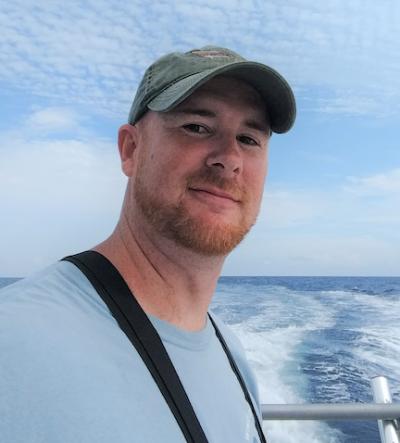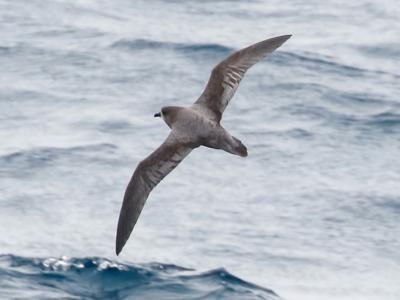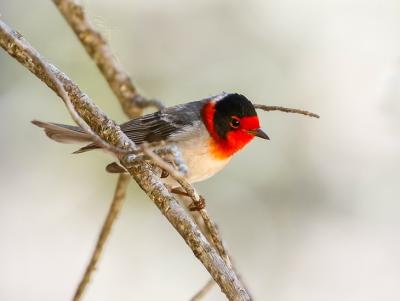Cruise: Pacific Coast in Fall
Albatrosses, Pterodromas, and Seabirding in Comfort
2026
Tour Price to be Determined
2026
Tour Price to be Determined
Fall is an excellent time to be at sea in the Eastern Pacific! Many of our summer residents are starting or ending their southern migrations, while the potential for rarities increases. Our Fall cruises are great opportunities to look for Fall specialties such as Buller’s, Flesh-footed and Short-tailed Shearwaters, as well as South Polar Skua. This season has also historically been a good time to look for mega-rarities like Short-tailed Albatross, Streaked Shearwater, or Mottled Petrel. Add in the comfort and stability of a large cruise ship, and you have a great alternative to see these Pacific seabirds!
We also offer several spring cruises on this same basic routing here.
11–15 October 2025 on Princess Cruises (Sapphire Princess) from Vancouver to Los Angeles (San Pedro): This 4-Day cruise with Princess Cruises departs from Vancouver in the afternoon, has three full days at sea and arrives in Los Angeles on the morning of 15 October. WINGS price (guiding while on ship) is $690 plus the cost of your berth (berth should be booked directly with Princess at the number below). Non-birders traveling with you are exempt from the WINGS charge. Berth prices for this cruise start at only about $378 per person (interior shared cabin) plus tax, gratuity, and port charges based on double occupancy (about $130 per person). Details on booking a berth with Princess Cruises can be found here.
19-25 September 2026 on Princess Cruises (Grand Princess) from Vancouver to Los Angeles (San Pedro): This 6-Day cruise with Princess cruises departs from Vancouver in the afternoon, has two full days at sea, a full day in San Francisco, another full day at sea, then a full day in Santa Barbara before arriving in Los Angeles the morning of 25 September. No land excursions will be organized. WINGS price (guiding while on ship) is $XXX plus the cost of your berth (berth should be booked directly with Princess at the number below). Non-birders traveling with you are exempt from the WINGS charge. Berth prices for this cruise start at $648 per person (interior shared cabin) plus tax, gratuity, and port charges based on double occupancy (about $XXX per person). Details on booking a berth with Princess Cruises can be found here. Details on booking a berth with Princess Cruises can be found here.
Note: The information presented below has been extracted from our formal General Information for this tour. It covers topics we feel potential registrants may wish to consider before booking space. The complete General Information for this tour will be sent to all tour registrants and of course supplemental information, if needed, is available from the WINGS office.
RESERVING YOUR CABIN WITH PRINCESS CRUISES: Your berth on this cruise should be booked over the phone with Princess Cruises to make sure your booking is added to our group number (see details below). All cabins will work equally well with the planned activities. Price depends largely on cabin class with cabin base prices beginning at about $350 per person (interior shared cabin) plus tax, gratuity, and port charges based on double occupancy (about $110). Princess Reservation Telephone: 1-800-901-1172 extension 21678.
Note: Because we’re a group, all bookings from North America should go through our group organizer with Princess Cruises, Melissa Mesker at 1-800-901-1172 ext. 21678 or [email protected] . Her hours are 7:00 am-3:45 pm Pacific Time, Monday – Friday. It’s best to book your cabin through the number above and not through a standard travel agency or website such as Kayak, Expedia, or Travelocity (or over the cruisie company’s website). If you get her voicemail leave a message with the following information (or dial 0 during the message for one of her support team).
Cruise Dates: 11- 15 October 2025 (PRINCESS CRUISES)
- Cruise Route: 4 Day Pacific Coastal (Vancouver, Canada to Los Angeles)
- Ship: Sapphire Princess
- Group Name: WINGS COASTAL 2025
- Our group code is TNC
- Our cruise number or voyage code is H529
Cruise Dates: 19-25 September 2026 (PRINCESS CRUISES)
- Cruise Route: 6 Day Pacific Coastal (Vancouver, Canada to Los Angeles)
- Ship: Grand Princess
- Group Name: WINGS FALL COASTAL 26
- Our group code is TNL
- Our cruise number or voyage code is A637
Choosing a cabin on the Sapphire or Grand Princess (Open Bow): The closest interior (non-view) cabins to the birding spot are on Deck 5, in the front of the ship, between the elevator and the laundry. If you are worried about the movement of the ship then more stable interior cabins are on Deck 5 near the Art Gallery, though these are also near the Casino and may be noisy. There are also interior cabins mid-ship on Deck 10.
If you prefer a more expensive cabin with an ocean view the closest cabins to the birding location are on Deck 8, in the bow of the ship. Cabins on deck 8 mid-ship are also close to the birding location and more stable than in the front.
Additional information to have at hand before calling to make your booking:
- - Your name(s) as they appear on your passports (first, middle and last)
- - Your date(s) of birth
- - Phone numbers, mailing addresses, and email addresses for all persons who do not have Captain’s Circle or Mariner member numbers
- - Preferred bed configuration (queen vs. twin) for all staterooms – please note for cabins of 3 or more bed configuration may not allow a queen bed. The specific cruise company can provide specific bedding configuration details for each cabin as needed.
- - Family stateroom configurations planned in advance (i.e., for families exceeding 4 persons; maximum stateroom occupancy is 4) or ask about Family Suite accommodations for up to 8 passengers.
- - Dining selections (early, first, or late Traditional Dining, or Anytime dining) Note: Select “Anytime” dining.
- - Any Special Requirements, including but not limited to: special dietary requests like food allergies and dietary restrictions (i.e., vegetarian, kosher, vegan, etc.), or medical considerations.
- - Any birthdays, anniversaries or other special occasions that you would like celebrated while onboard
As a general rule, your passport should be valid for at least six months after the date the tour ends. It is always a good idea to take photocopies of your passport and air ticket with you when traveling abroad. They can prove invaluable in helping you get replacements if your original documents are lost or stolen. You should pack the photocopies separately from the originals.
SECOND ID: When boarding on the cruise, the staff will sometimes keep your passport until the end of the cruise (and present it to the immigration service at each landing if applicable). That means that during the land excursions, you will travel with your cabin key replacing your ID on the ship. It is highly recommended you bring a second ID with photo (Driver’s license for example) in case you need to prove your identity for any reason.
TRANSFER BETWEEN AIRPORT AND HARBOR: Transfers to the harbor (from the airport) and back from the harbor are not included in the WINGS quote. We highly recommend that you organize your transfer to/from the airports through Holland America or Princess Cruises. It is easier to do it this way. They can also help with airline reservations.
Important: The cruise lines will not allow you to take one of their shuttles between the airport and harbor if your flight time for your arrival/departure is under the 6hr minimum before/after your embarkation/ disembarkation. In this case you will be obliged to organize your transfer by yourself (by taxi for example), but we highly recommend considering at least 6 hours between your flight and embarkation/disembarkation.
HEALTH: The most current information about travelers’ health recommendations can be found on the Centers for Disease Control’s Travel Health website at http://wwwnc.cdc.gov/travel/destinations/list. Specific vaccinations and proof thereof may be required to enter the country.For entry and exit information please visit the U.S. State Department’s website at https://travel.state.gov/content/travel.html. We strongly recommend contacting your doctor well in advance of your tour’s departure as some medications must be initiated weeks before the period of possible exposure.
Holland America and Princess Cruises places a strong emphasis on keeping healthy and many Purell hand disinfectant are provided throughout the ship. Unfortunately with 2000+ customers on the ship (plus a crew of over 1000), it is always possible to catch a bug, and we recommend bringing cough and cold medications.
Since it may be impossible to obtain personal medications while on the cruise, please bring what you will need.
SMOKING: We follow the cruise lines policy while onboard ship. Clearly marked “Designated Smoking Areas” are available onboard. Generally, these areas include cigar lounges, a section of the nightclub, as well as a portion of the open decks. Please do not smoke near the birding group or in your staterooms. The use of electronic cigarettes is allowed within the confines of the guest’s stateroom (balcony not included) and within designated smoking areas only.
PACE OF THE TOUR: The main tour starts after meeting on the cruise ship at a time and location to be discussed in your Final Information packet sent about a month prior to the cruise. The location of the group for birding while on board the ship will depend on the weather conditions and time of the day. This will be explained by your leader(s) during the first meeting. When sailing, the leader(s) will indicate exactly where and when they will be birding, and you can join them for as long as you want: for just a couple of hours if you also want to enjoy some of the activities offered by the cruise line, or full day if you don’t want to miss any seabirding action.
During the sailing days, the leader(s) are usually on deck birding from dawn to 8:00 p.m. and you can join them when and as long as you want. The leader(s) will need to take occasional breaks, of course. There may of course be special areas during which we’ll want to be on deck regardless of the time. The leader(s) will brief you on these well in advance.
CURRENCY: USD on board ship. Your credit card will be used for incidentals and drinks, etc.
CLIMATE: Bring plenty of warm, layered clothing for being out on the decks for hours. It will be quite chilly in spring! Wool cap, light gloves, down parka or down jacket or vest and sweater with windproof jacket, rain pants to cut any wind and/or a light pair of long underwear. Footgear should be the MOST comfortable thing you have for standing for a bunch of hours. For dinner attire, see below, under Meals. Bring a bathing suit if you want to visit the pool, jacuzzi, etc. There is also a fitness room.
ACCOMMODATIONS: During the cruise, you can choose between several levels of accommodations.
FOOD: An impressive variety of food is served on board ship. Food is served 24 hours a day, and there is no obligation to eat all meals with the group. For lunch, the easiest option is usually to eat at one of the buffets or have a pizza or sandwich. The buffet option is available for dinner as well, though some participants may opt to have a more formal dining experience at one of the ship’s restaurants. Each day the leader will let you know where and when the group will meet for the daily list round-up, and at which restaurant the group will take dinner.
Note: Be sure to select “Anytime dining” when registering for your cabin booking with Holland America Cruises.
DRINKS ON BOARD: The cruise lines offer at no charge water, ice tea, or lemonade. When on board, WINGS doesn’t cover other drinks. Therefore, any other drinks such soft drinks, mineral water, or any kind of alcoholic beverage will be charged to you. Luggage is scanned every time we go on board, and only one bottle of wine, for the entire cruise, is accepted per passenger. If you bring more than one bottle (or another bottle at another landing) Holland and Princess will charge you a corkage fee (approximately 15 US$ per bottle).
TIPPING: Gratuities for WINGS leaders are at your discretion and are not included in the tips that the cruise line adds. The cruise line simplifies the tipping process by adding, a discretionary gratuity of $16.50 per guest for suites, $15.50 per guest for mini-suites and $14.50 per guest (including children) in all other staterooms, per day, is automatically added to your shipboard account on a daily basis. This gratuity will be shared among those staff who help provide and support your cruise experience, including all waitstaff, stateroom stewards, buffet stewards, and housekeeping staff across the fleet.
INTERNET: Internet is available on the cruise ship but is quite expensive and often very slow.
ELECTRICITY: On the ship, current is 220V AC. The outlets in your rooms are the standard flat pin as in the United States. Most rooms have two outlets; the obvious one at the desk in the room but also a second behind the TV (which may or may not require unplugging the TV). If you have more than four items you’ll need to charge, it’s recommended to bring a plug-in that will give you more outlets. You shouldn’t have any issues plugging in anything that is considered dual-voltage (120/220). Check for this in the fine print on your device or adaptor. You may want to consult Magellan’s International Travel (www.magellans.com), which features a complete range of adapters and converters (and has details on whether or not you’ll need them).
DRESS: Informal dress is acceptable everywhere, but a nicer outfit is useful if attending more formal dinners on your own or with the group at the end of the cruise.
Approximate Routing (Ports of Call vary depending on sailing)
2024 Narrative
Fall in the Eastern Pacific can be an incredible time to be offshore, and our 4-Day October cruise aboard MS Koningsdam was no exception! From our incredibly stable ship, we were able to see superlative marine life, from the long-lived Laysan Albatross to long-distance travelers such as Buller’s and Pink-footed Shearwaters, Long-tailed Jaegers, and South Polar Skuas. Other avian highlights included Red-billed Tropicbird and Tufted Puffin. The mammal show was equally impressive, featuring Dall’s and Harbor Porpoise; Orca; Blue, Fin, Common Minke and Humpback Whales; Risso’s and Northern Right Whale Dolphins; and pinnipeds such as Harbor, Northern Elephant and Northern Fur Seal.
Day 1: After a brief introduction and orientation meeting, our group eagerly gathered on the Promenade deck port to prepare for the departure of the Holland America Koningsdam, our home for this southbound cruise. While at the dock, we scanned for Short-billed and Glaucous-winged Gulls, Pelagic, Brandt’s and Double-crested Cormorants, and Western Grebe. Getting underway a little after 4, we slowly passed under the Lions Gate en route to the Strait of Juan de Fuca and open water. Shortly after, our group spotted a small pod of resident Orca, as well as a few spouting Humpback Whales and the subtle fins of shy Harbor Porpoise. Pacific and Common Loons flew past the ship and our gull diversity increased, adding California, Heermann’s, Bonaparte’s and our first Sabine’s Gull. As our light waned, we enjoyed the pink sky around Mount Rogers for what seemed like hours, then retired to the aft deck of the Lido Market for our nightly countdown.
Day 2: Our first full day at sea started offshore of Pacific County, Washington, as we began to pick out our first tubenoses, Sooty Shearwaters and Northern (Pacific) Fulmars. Keen eyes were able to pick out the similar Short-tailed Shearwater, a Fall/Winter specialty on the West Coast. We would also add Fork-tailed Storm-Petrel and our first Buller’s Shearwaters. Buller’s are easily one of the most attractive shearwaters in the world, and late Summer to Fall can be a great time to see these tropical seabirds as they migrate south to their breeding grounds off New Zealand. Passing further south in to Oregon Waters brought us our first Black-footed Albatross, as well as good looks at dynamic Dall’s Porpoises. Red Phalaropes flushed from our bow wake, with the occasional Red-necked Phalarope showing up in the mix.
In the afternoon, we detected our first Pink-footed Shearwater, the largest regularly occurring shearwater in the Eastern Pacific. These birds breed off of Chile in the austral summer and disperse to the Northern Hemisphere to feed. In addition to these long-distance travelers, we picked up our first Tufted Puffins of the journey, as well as Leach’s Storm-Petrel and Pomarine Jaeger. Northern Fulmar numbers increased, with dark, light, and intermediate morphs being seen. We also had occasional glimpses at our more common alcids, such as Rhinoceros and Cassin’s Auklet, as well as Common Murre. Towards the latter part of the afternoon, we were able to spot a distant Laysan Albatross. While this bird never came close, it did stay with us for over 30 minutes, giving all passengers a chance to see a species which holds the longevity record for all birds, with a banded female named Wisdom still laying eggs at the ripe old age of 74! As our time on deck ended offshore of Curry County, OR, we were treated to distant blows from Blue and Fin Whales, the largest and second largest whales in the world. Talk about a superlative end to the day!
Day 3: Cruise ships tend to attract vagrant landbirds, and the Koningsdam was no exception. On our second day at sea, west of Sonoma County, CA, our participants were able to see Golden-crowned, White-crowned, Grasshopper, Fox, AND Savannah Sparrows, as well as Acorn Woodpecker and Peregrine Falcon! We also found larger numbers of seabirds, with impressive flocks of Bullers, Pink-footed and Sooty Shearwaters, attended by Pomarine and Parasitic Jaegers, and no less than a dozen South Polar Skuas. As their name suggests, these skuas nest in the Antarctic, migrating to northern waters of the Atlantic and Pacific during austral winter to feed. We spotted another young Tufted Puffin and our only Black-legged Kittiwake of the trip, while Pacific White-sided Dolphins played in our wake. After an early afternoon lull, we found ourselves with increasing numbers of Sabine’s Gulls and jaegers. Most were able to get on slimmer Long-tailed Jaeger as it passed; we were lucky to see this bird, as most are south of our waters by late October. As the light faded offshore of San Luis Obispo, we retired to our usual spot for the nightly checklist.
Day 4: The morning of Day 4 found us in the warmer waters of LA County, as we made our way towards Avalon. Brown Pelicans cruised around the calm waters, while a few diminutive Black-vented Shearwaters were picked out of the more common Pink-footeds flying past. A Red-billed Tropicbird gave poor looks as it flew away, but several passengers were able to see it before it disappeared. A distant booby (likely a Cocos Brown Booby) also refused to give satisfactory views. Nearing Santa Catalina Island, our group was treated to several groups of Grampus (Risso’s Dolphins), as well as mixed pods of both Short-beaked and Long-beaked Common Dolphins. There was even a brief glimpse at a Common Minke Whale. We arrived in port in Avalon at 930, and the passengers went their separate ways to enjoy their day at this beautiful offshore paradise. At 4pm, we gathered on deck again to scan the cobalt waters surrounding the island until dark. It was interesting to watch the Heermann’s Gulls, the poor man’s jaegers, as they harassed Brown Pelicans in hopes of snatching their hard-won catches.
Our group met for dinner in the main dining room to celebrate our time together and enjoy the excellent food and drinks available. Afterwards, we went over our final species lists. Everyone was given the opportunity to reminisce on their favorite observation or moment, and we said our goodbyes ahead of arriving in San Diego the next morning; a fitting end to a fantastic voyage!
- Ed Corey
The “Tour Information” tab links to details on booking berths, deposit and payment dates and other relevant information.
* The WINGS tour price covers the leaders’ guiding and time on board ship.
* The deposit for this tour is $250.
** Note that a WINGS deposit or payment is not required of non-birding companions who should not expect to join the daytime birding activities. Non-birding companions must of course book their cruise berth with the cruise line.
The max number of birders for these cruises is 8 with one leader and 13 with two leaders.



















